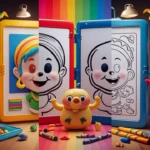Why Everyone Needs Infographics Today
Have you ever scrolled through social media and stopped at a colorful, eye-catching image full of interesting facts? That’s an infographic! And guess what? You don’t need to be a professional designer anymore to create amazing ones.
- Why Everyone Needs Infographics Today
- What is an Infographic? (Explained Like You’re Five)
- Why AI is the Best Friend for Making Infographics
- 1. Speed Like Lightning
- 2. No Design Skills Needed
- 💖 You Might Also Like
- 3. Hundreds of Templates
- 4. Smart Suggestions
- 5. Cost-Effective
- Who Needs AI Infographic Tools?
- Marketers and Business People
- Teachers and Educators
- Students
- Content Creators and Bloggers
- Small Business Owners
- Non-Profit Organizations
- The Best AI Tools for Creating Infographics
- 1. Canva AI (Magic Design)
- ✨ More Stories for You
- 2. Visme AI
- 3. Piktochart AI
- 🌟 Don’t Miss These Posts
- 4. Venngage AI
- 5. Simplified AI
- 6. Adobe Express (with Adobe Firefly AI)
- 7. Snappa
- 8. Designs.ai (Designmaker)
- 9. Infogram
- 10. Beautiful.ai
- How to Choose the Right AI Tool for You
- If you’re a beginner:
- If you work with lots of data:
- If you need it for business:
- If you’re in a hurry:
- If you want interactive infographics:
- If you need everything in one place:
- Tips for Creating Amazing Infographics (Even with AI)
- 1. Start with One Clear Message
- 2. Use Colors That Match
- 3. Keep Text Short
- 4. Tell a Story from Top to Bottom
- 5. Use Icons and Illustrations
- 6. Make Numbers Big and Bold
- 7. Leave White Space
- 8. Think About Your Audience
- 9. Make It Mobile-Friendly
- 10. Always Include Your Source
- Real-Life Examples: How People Use AI Infographics
- Example 1: The Teacher
- Example 2: The Small Business Owner
- Example 3: The Marketing Manager
- Example 4: The Student
- Example 5: The Non-Profit
- Common Mistakes to Avoid
- 1. Too Much Information
- 2. Tiny Text
- 3. Clashing Colors
- 4. No Visual Hierarchy
- 5. Ignoring Your Brand
- 6. Using Bad Quality Images
- 7. Forgetting to Proofread
- 8. Making It Too Complicated
- The Future of AI and Infographics
- Real-Time Data Infographics
- Voice-Activated Design
- AR Infographics
- AI That Knows Your Style
- Smarter Content Suggestions
- Getting Started Today: Your Action Plan
- Step 1: Pick Your Tool (Day 1)
- Step 2: Create a Free Account (Day 1)
- Step 3: Choose a Template (Day 1)
- Step 4: Customize It (Day 1-2)
- Step 5: Get Feedback (Day 2)
- Step 6: Refine and Publish (Day 3)
- Step 7: Practice (Ongoing)
- Frequently Asked Questions
- Conclusion: Your Infographic Journey Starts Now
Imagine you’re a teacher trying to explain how plants grow. Instead of just talking, you can show a beautiful picture with drawings, arrows, and fun facts. Or maybe you’re selling lemonade and want to show people why your lemonade is the best. An infographic can do that in seconds!
The world has changed. People don’t want to read long, boring text anymore. They want pictures, colors, and information that’s easy to understand. This is where AI (Artificial Intelligence) comes to save the day. AI tools can help you create professional infographics in minutes, even if you’ve never designed anything before.
In this guide, we’ll explore the best AI tools for creating infographics, how they work, and why they’re perfect for marketers, teachers, students, and anyone who wants to share information in a fun, visual way.
What is an Infographic? (Explained Like You’re Five)
Let’s start with the basics. An infographic is like a poster that tells a story using pictures, colors, numbers, and short words. Think of it as a comic book for information!
Instead of writing a whole essay about why you should eat vegetables, an infographic might show:
- A big carrot with a smile
- Numbers showing vitamins inside
- Colorful arrows pointing to a strong, healthy person
- Fun facts in bubbles
Infographics make learning and understanding super easy. Your brain loves pictures! Scientists say we remember 80% of what we see but only 20% of what we read. That’s why infographics are so powerful.
Why AI is the Best Friend for Making Infographics
Remember when making a poster for school took hours? You needed scissors, glue, magazines, colored markers, and a lot of patience. Sometimes it looked messy, and sometimes you ran out of time.
AI changes everything. Here’s why AI is amazing for creating infographics:
1. Speed Like Lightning
AI can create a complete infographic in 2-5 minutes. What used to take hours now takes less time than making a sandwich!
2. No Design Skills Needed
You don’t need to go to art school. You don’t need to know what colors match. AI knows all of this already. You just tell it what you want, and it creates something beautiful.
💖 You Might Also Like
3. Hundreds of Templates
AI tools come with templates for everything: business reports, school projects, health tips, cooking recipes, sports stats, and more. Just pick one and customize it.
4. Smart Suggestions
AI is like having a smart friend who knows design. It suggests colors that look good together, fonts that are easy to read, and layouts that make sense.
5. Cost-Effective
Hiring a professional designer can cost hundreds of dollars. Many AI tools are free or very cheap. Some cost less than a pizza!
Who Needs AI Infographic Tools?
Marketers and Business People
If you’re selling something, you need to catch people’s attention. Marketers use infographics to:
- Show product benefits quickly
- Explain complicated services simply
- Share statistics and research
- Create social media posts that get shared
- Make email newsletters more interesting
- Present data to their bosses
Imagine you’re selling a fitness app. Instead of writing paragraphs, you create an infographic showing:
- A before-and-after picture
- Number of calories burned
- User testimonials in colorful boxes
- Easy steps to get started
This gets more customers than boring text!
Teachers and Educators
Teachers have the hardest job: making kids pay attention! AI infographics help teachers:
- Explain difficult topics visually
- Create study guides that students actually use
- Make classroom posters in minutes
- Show historical timelines
- Illustrate science concepts
- Compare and contrast ideas
A teacher explaining the water cycle can show clouds, rain, rivers, and evaporation all connected with arrows and fun colors. Students remember it forever!
Students
Students can use AI to:
- Make school projects look professional
- Create presentation slides
- Summarize book reports
- Show research findings
- Make study notes more interesting
- Impress teachers with visual assignments
Instead of a boring report on dinosaurs, imagine showing a timeline of when each dinosaur lived, how big they were compared to humans, and what they ate—all in one colorful infographic!
Content Creators and Bloggers
People who create content online need eye-catching visuals. They use infographics to:
- Get more followers and engagement
- Explain tips and tricks
- Share statistics and facts
- Make pins for Pinterest
- Create Instagram carousels
- Illustrate blog posts
Small Business Owners
If you own a bakery, restaurant, gym, or any small business, infographics help you:
- Show your menu attractively
- Explain your services
- Share customer reviews
- Announce special offers
- Create flyers and posters
Non-Profit Organizations
Organizations that help people need to spread awareness. Infographics help them:
- Show impact and statistics
- Explain their mission
- Share success stories
- Create fundraising materials
- Educate the public
The Best AI Tools for Creating Infographics
Now let’s explore the best AI tools available. Each one has special features, and we’ll explain them in simple words.
1. Canva AI (Magic Design)
What it is: Canva is like a toy box full of design tools. Their AI feature called “Magic Design” is incredibly smart.
✨ More Stories for You
How it works: You type what you want (like “benefits of drinking water”), and Canva’s AI creates multiple infographic options instantly. You can then edit colors, text, images, and everything else.
Best features:
- Millions of templates
- Drag-and-drop (super easy)
- Free version available
- Works on computers and phones
- Huge library of photos and illustrations
- Can create presentations, posters, social media posts, and more
Who should use it: Everyone! It’s perfect for beginners and experts. Teachers love it for classroom materials. Marketers use it for professional campaigns.
Price: Free version is great! Pro version costs about $13 per month and gives you more templates and features.
Why it’s awesome: Canva is like the Swiss Army knife of design. You can make almost anything. The AI suggestions are smart, and it’s so easy that kids can use it.
2. Visme AI
What it is: Visme specializes in infographics, presentations, and data visualization. Their AI is focused on making information beautiful.
How it works: Visme’s AI Designer asks you questions about your project: What’s it about? Who’s it for? What style do you like? Then it creates custom infographics based on your answers.
Best features:
- Excellent for data-heavy infographics
- Great charts and graphs
- Animation options (your infographic can move!)
- Collaboration tools (work with friends or team)
- Smart templates for different industries
Who should use it: Marketers and business professionals who need to present data. Also great for students doing research projects.
Price: Free version available. Premium starts at $15 per month.
Why it’s awesome: If you need to show numbers, statistics, or survey results, Visme makes them look incredible. The charts practically create themselves!
3. Piktochart AI
What it is: Piktochart is designed specifically for infographics, reports, and posters. Their AI helps you structure information logically.
How it works: You enter your text or data, and Piktochart’s AI suggests the best way to visualize it. It automatically chooses icons, layouts, and color schemes.
Best features:
- Super focused on infographics
- Medical and educational templates
- Easy map creation
- Report generator
- Print-ready designs
Who should use it: Educators, healthcare workers, non-profits, and anyone creating informational content.
🌟 Don’t Miss These Posts
Price: Free plan available. Paid plans start at $14 per month.
Why it’s awesome: Piktochart understands how to organize information so it makes sense. It’s like having a librarian who knows exactly where everything should go.
4. Venngage AI
What it is: Venngage is another infographic specialist with powerful AI features that help you transform text into visuals.
How it works: Their “Smart Templates” adapt to your content. You can paste your text, and the AI suggests the best infographic type and layout.
Best features:
- Industry-specific templates
- Accessible designs (helps people with disabilities)
- Team collaboration
- Brand kit (keeps your colors and logos consistent)
- Easy sharing options
Who should use it: Businesses, marketers, HR departments, and organizations that need consistent branding.
Price: Free plan available. Premium starts at $19 per month.
Why it’s awesome: Venngage is professional and polished. If you need infographics for business presentations or official reports, this is perfect.
5. Simplified AI
What it is: Simplified is an all-in-one content creation platform with impressive AI capabilities for infographics.
How it works: Their AI can generate entire infographic designs from just a prompt. You can say “Create an infographic about healthy eating for kids,” and it does it!
Best features:
- Text-to-design AI
- Social media integration
- Content calendar
- Video and animation tools
- Copywriting AI (writes your text too!)
Who should use it: Social media managers, content creators, and small businesses managing their own marketing.
Price: Free plan available. Pro plans start at $12 per month.
Why it’s awesome: Simplified does everything in one place. You can create the infographic, write the caption, and schedule it for social media—all without leaving the platform!
6. Adobe Express (with Adobe Firefly AI)
What it is: Adobe Express is Adobe’s easy version of their design tools, now powered by Firefly AI.
How it works: You can use AI to generate custom images, suggest layouts, and even create text effects. It’s professional-grade but simplified for regular people.
Best features:
- Powered by Adobe’s professional technology
- AI image generation
- Quick actions (remove backgrounds, resize automatically)
- Thousands of fonts
- Adobe Stock integration
Who should use it: People who want professional quality but aren’t professional designers. Great for freelancers and entrepreneurs.
Price: Free version available. Premium is $10 per month.
Why it’s awesome: It’s made by Adobe, the same company professionals use. You get professional quality without the complexity.
7. Snappa
What it is: Snappa focuses on speed and simplicity. Their AI helps you create infographics incredibly fast.
How it works: Choose a template, and Snappa’s smart features suggest colors, fonts, and layouts based on current design trends.
Best features:
- Super fast loading
- No design experience needed
- Preset sizes for all social media
- Graphics library
- Buffer integration (schedule posts)
Who should use it: Busy marketers and entrepreneurs who need good designs quickly.
Price: Plans start at $10 per month (no free plan, but there’s a trial).
Why it’s awesome: Speed! If you need an infographic in 2 minutes, Snappa delivers.
8. Designs.ai (Designmaker)
What it is: Designs.ai is a suite of AI tools, and Designmaker is their infographic creator.
How it works: Their AI is very smart about color psychology and design principles. It creates designs that not only look good but also communicate effectively.
Best features:
- Voice-to-design (speak your ideas!)
- Smart color matching
- Font pairing AI
- Logo maker included
- Multiple AI tools in one package
Who should use it: Startups and businesses building their brand from scratch.
Price: Plans start at $29 per month (includes all AI tools).
Why it’s awesome: The AI really understands design principles. Your infographics won’t just be pretty—they’ll be effective at communicating your message.
9. Infogram
What it is: Infogram specializes in data visualization and interactive infographics.
How it works: Upload your data (from Excel, Google Sheets, etc.), and Infogram’s AI suggests the best way to visualize it with charts, maps, and graphs.
Best features:
- Interactive infographics (people can click and explore)
- Real-time data connection
- Excellent for dashboards
- Map tools
- Embed anywhere
Who should use it: Analysts, journalists, researchers, and anyone working with lots of data.
Price: Free plan available. Pro plans start at $19 per month.
Why it’s awesome: Your infographics can be interactive! People can hover over sections to see more information, which is perfect for websites and presentations.
10. Beautiful.ai
What it is: Beautiful.ai creates presentations, but their infographic slides are spectacular and AI-powered.
How it works: The AI automatically adjusts layouts as you add content. Everything always looks balanced and professional.
Best features:
- Smart templates that adapt
- Team collaboration
- Animation and transitions
- Modern, trendy designs
- Automatic formatting
Who should use it: People who need infographics for presentations—startup founders, sales teams, consultants.
Price: Plans start at $12 per month.
Why it’s awesome: The AI is constantly adjusting and improving your design as you work. You literally can’t make something ugly!
How to Choose the Right AI Tool for You
With so many options, how do you pick? Here’s a simple guide:
If you’re a beginner:
Choose Canva. It’s the easiest and has the most tutorials online.
If you work with lots of data:
Choose Visme or Infogram. They make numbers look beautiful.
If you need it for business:
Choose Venngage or Adobe Express. They look professional and have business templates.
If you’re in a hurry:
Choose Snappa or Simplified. They’re built for speed.
If you want interactive infographics:
Choose Infogram. People can click and explore your data.
If you need everything in one place:
Choose Simplified. It does infographics, social media, videos, and more.
Tips for Creating Amazing Infographics (Even with AI)
AI is smart, but you’re the creative director! Here are tips to make your infographics stand out:
1. Start with One Clear Message
Don’t try to say everything. Pick one main idea. For example: “Coffee gives you energy” is better than trying to explain the entire history of coffee.
2. Use Colors That Match
Most AI tools suggest colors, but remember:
- Blue = trust, calm
- Red = excitement, urgency
- Green = nature, health
- Yellow = happiness, warning
- Purple = luxury, creativity
3. Keep Text Short
Use bullet points, not paragraphs. Every word should earn its place. If you can say it in 5 words instead of 10, do it!
4. Tell a Story from Top to Bottom
Infographics should flow like a story. Start with a question or problem at the top, explain in the middle, and end with a solution or conclusion at the bottom.
5. Use Icons and Illustrations
Pictures are faster than words. Instead of writing “time,” show a clock. Instead of writing “money,” show coins or dollar signs.
6. Make Numbers Big and Bold
Statistics should jump off the page. If 75% of people love chocolate, make that “75%” huge!
7. Leave White Space
Don’t fill every inch with stuff. Empty space makes your infographic easier to read and more elegant.
8. Think About Your Audience
Creating an infographic for kids? Use bright colors and fun fonts. For business? Use professional colors like blue, gray, or navy.
9. Make It Mobile-Friendly
Most people view content on phones. Make sure your text is big enough to read on a small screen.
10. Always Include Your Source
If you’re sharing facts or statistics, say where you got them. It makes you trustworthy!
Real-Life Examples: How People Use AI Infographics
Example 1: The Teacher
Mrs. Johnson teaches 5th-grade science. She used Canva AI to create an infographic about the solar system. It showed all the planets in order, their sizes compared to Earth, and fun facts about each one. Her students loved it so much they asked for copies to hang in their rooms!
Example 2: The Small Business Owner
Carlos owns a pizza restaurant. He used Piktochart to create an infographic showing “Our Pizza Journey”—from selecting tomatoes to delivering hot pizza to your door. He posted it on Instagram, and it got shared 500 times! New customers kept mentioning they saw his infographic.
Example 3: The Marketing Manager
Priya works for a company selling eco-friendly water bottles. She used Visme to create an infographic showing how much plastic waste one person creates in a year versus using their bottle. The infographic was used in their website, emails, and social media. Sales increased by 40%!
Example 4: The Student
Tommy had to do a project on Abraham Lincoln. Instead of a boring report, he used Venngage to create a timeline infographic showing Lincoln’s life events, with pictures and dates. He got an A+ and his teacher asked if she could use it as an example for future students!
Example 5: The Non-Profit
An animal shelter used Infogram to create an interactive infographic showing their impact: dogs adopted, cats rescued, medical treatments provided. Donors could click on each number to see stories. Donations increased by 60%!
Common Mistakes to Avoid
Even with AI helping, people still make mistakes. Here’s what NOT to do:
1. Too Much Information
Don’t turn your infographic into an essay. If you have too much to say, make two infographics!
2. Tiny Text
If people need a magnifying glass, your text is too small. Make it readable!
3. Clashing Colors
Neon pink on neon yellow hurts people’s eyes. Trust the AI’s color suggestions or use color palette tools.
4. No Visual Hierarchy
The most important information should be biggest and boldest. Guide people’s eyes through your design.
5. Ignoring Your Brand
If you’re creating infographics for a business, keep colors and fonts consistent with your brand.
6. Using Bad Quality Images
Pixelated or blurry images look unprofessional. Use high-quality images from the AI tool’s library.
7. Forgetting to Proofread
AI is smart, but it’s not perfect. Always check for spelling mistakes and accurate information.
8. Making It Too Complicated
Simple is powerful. Don’t add decorations just because you can. Every element should have a purpose.
The Future of AI and Infographics
The future is exciting! Here’s what’s coming:
Real-Time Data Infographics
Imagine infographics that update themselves automatically. Your sales infographic updates every hour with new numbers!
Voice-Activated Design
Soon you’ll be able to say “Create an infographic about healthy breakfast” and watch it appear in seconds.
AR Infographics
Augmented Reality will let people see infographics floating in the air through their phones or glasses!
AI That Knows Your Style
AI will learn your preferences and automatically create infographics in your unique style every time.
Smarter Content Suggestions
AI will not only design the infographic but also suggest what information to include based on what’s trending and what people want to know.
Getting Started Today: Your Action Plan
Ready to create your first AI infographic? Here’s a simple plan:
Step 1: Pick Your Tool (Day 1)
Based on our guide, choose one tool to start with. We recommend Canva for beginners.
Step 2: Create a Free Account (Day 1)
Sign up takes just 2 minutes. Most tools let you start for free.
Step 3: Choose a Template (Day 1)
Browse templates related to your topic. Don’t start from scratch on your first try!
Step 4: Customize It (Day 1-2)
Change the text to your information. Replace images with ones you like. Adjust colors to your preference.
Step 5: Get Feedback (Day 2)
Show it to a friend, colleague, or family member. Ask: “Is this clear? Is it attractive? Would you read it?”
Step 6: Refine and Publish (Day 3)
Make final changes based on feedback, then download and share your infographic!
Step 7: Practice (Ongoing)
Create one infographic per week. You’ll become faster and better with practice!
Frequently Asked Questions
Q: Do I need to pay for AI infographic tools? A: Many tools offer free versions that are great for starting. You only need paid versions if you want more templates, features, or to remove watermarks.
Q: Can I use AI infographics for commercial purposes? A: Yes! Most tools allow commercial use, but check their specific license. Premium accounts usually have full commercial rights.
Q: How long does it take to create an infographic? A: With AI, you can create a simple infographic in 5-10 minutes. More complex ones might take 30 minutes to an hour.
Q: Do I own the infographics I create? A: Yes! Once you create and download them, they’re yours to use however you want.
Q: Can AI create infographics in different languages? A: Yes! Most AI tools support multiple languages. You can create infographics in Spanish, French, German, Hindi, and many others.
Q: What size should my infographic be? A: It depends where you’ll use it:
- Instagram: 1080 x 1080 pixels (square) or 1080 x 1350 (portrait)
- Pinterest: 1000 x 1500 pixels
- Website: 800 x 2000 pixels
- Print: 8.5 x 11 inches or A4
Q: Can I make animated infographics? A: Yes! Tools like Visme, Canva, and Simplified offer animation features.
Q: Is it legal to use stock images in my infographic? A: If you use images from your AI tool’s library, yes! They have the licenses. Don’t use random Google images—they might be copyrighted.
Conclusion: Your Infographic Journey Starts Now
Creating infographics used to be hard. You needed expensive software, design skills, and lots of time. But AI has changed everything. Now, anyone—teachers, students, business owners, marketers, or just curious people—can create professional, beautiful infographics in minutes.
The tools we’ve explored are like magic wands for visual communication. They understand design, color, layout, and what makes people stop scrolling and actually pay attention. Whether you choose Canva’s versatility, Visme’s data prowess, Piktochart’s simplicity, or any other tool, you’re equipped to create amazing visual content.
Remember, the best infographic tool is the one you actually use. Don’t get paralyzed trying to pick the perfect option. Start with one tool, create something, learn from the experience, and get better with each attempt.
The world needs your ideas, your knowledge, and your stories. And now, with AI helping you, you can share them in ways that are colorful, engaging, and impossible to ignore.
So what are you waiting for? Open one of these AI tools, pick a template, and start creating. Your first infographic is just minutes away. Who knows? It might be shared thousands of times, teach hundreds of students, or help a business grow.
The power to communicate visually is now in your hands. Use it wisely, use it creatively, and most importantly—have fun! Because when you enjoy creating, others will enjoy viewing.
Welcome to the exciting world of AI-powered infographics. Your visual storytelling adventure begins today!
Quick Recap – Best AI Tools Summary:
- Canva AI – Best for beginners and all-around use
- Visme AI – Best for data visualization
- Piktochart – Best for educators and informational content
- Venngage – Best for business and professional use
- Simplified – Best for social media managers
- Adobe Express – Best for professional quality
- Snappa – Best for speed
- Designs.ai – Best for brand building
- Infogram – Best for interactive infographics
- Beautiful.ai – Best for presentations
Remember: The best tool is the one that fits YOUR needs and that you’ll actually use. Start free, experiment, and find your favorite. Happy creating!















